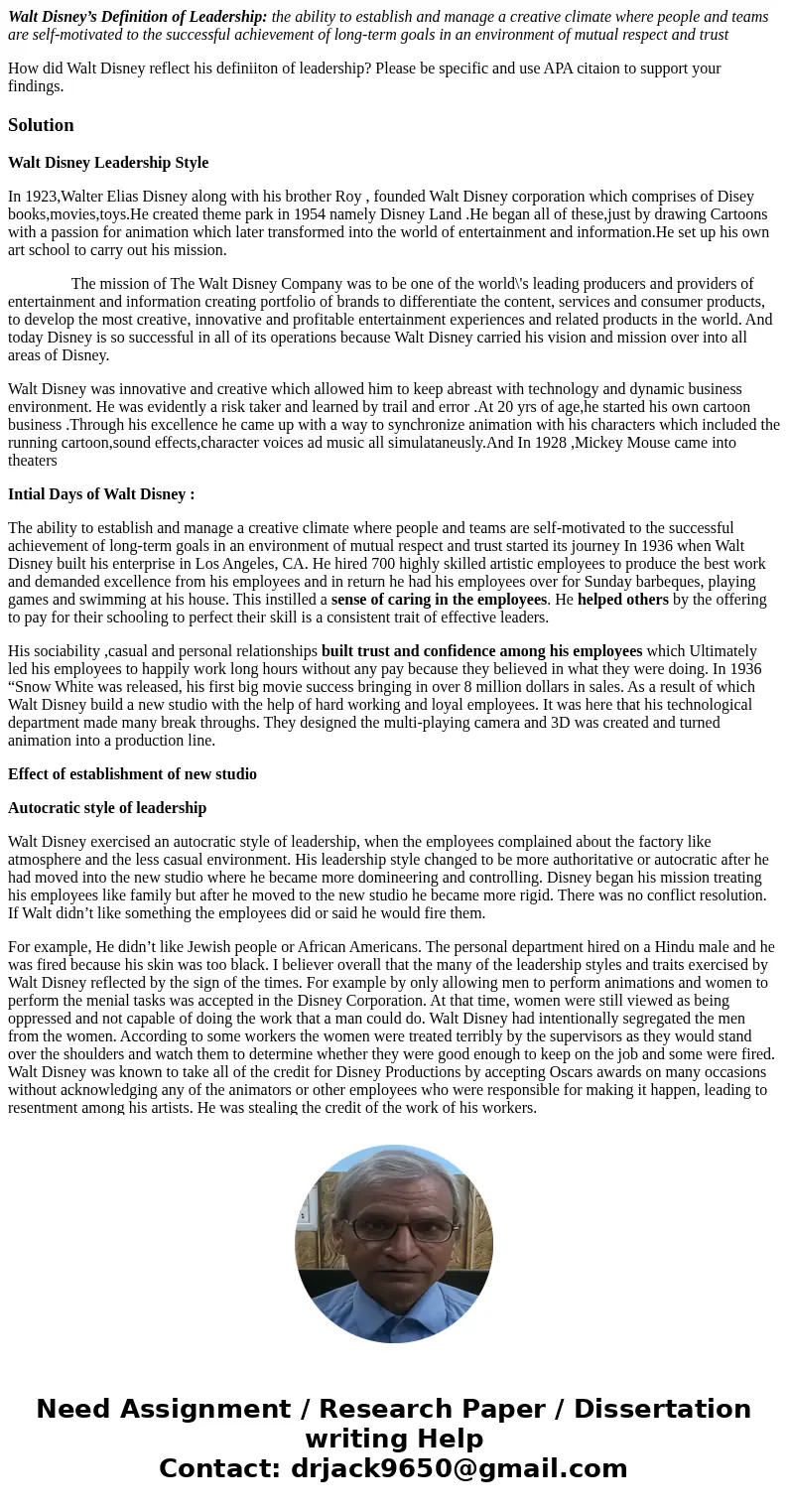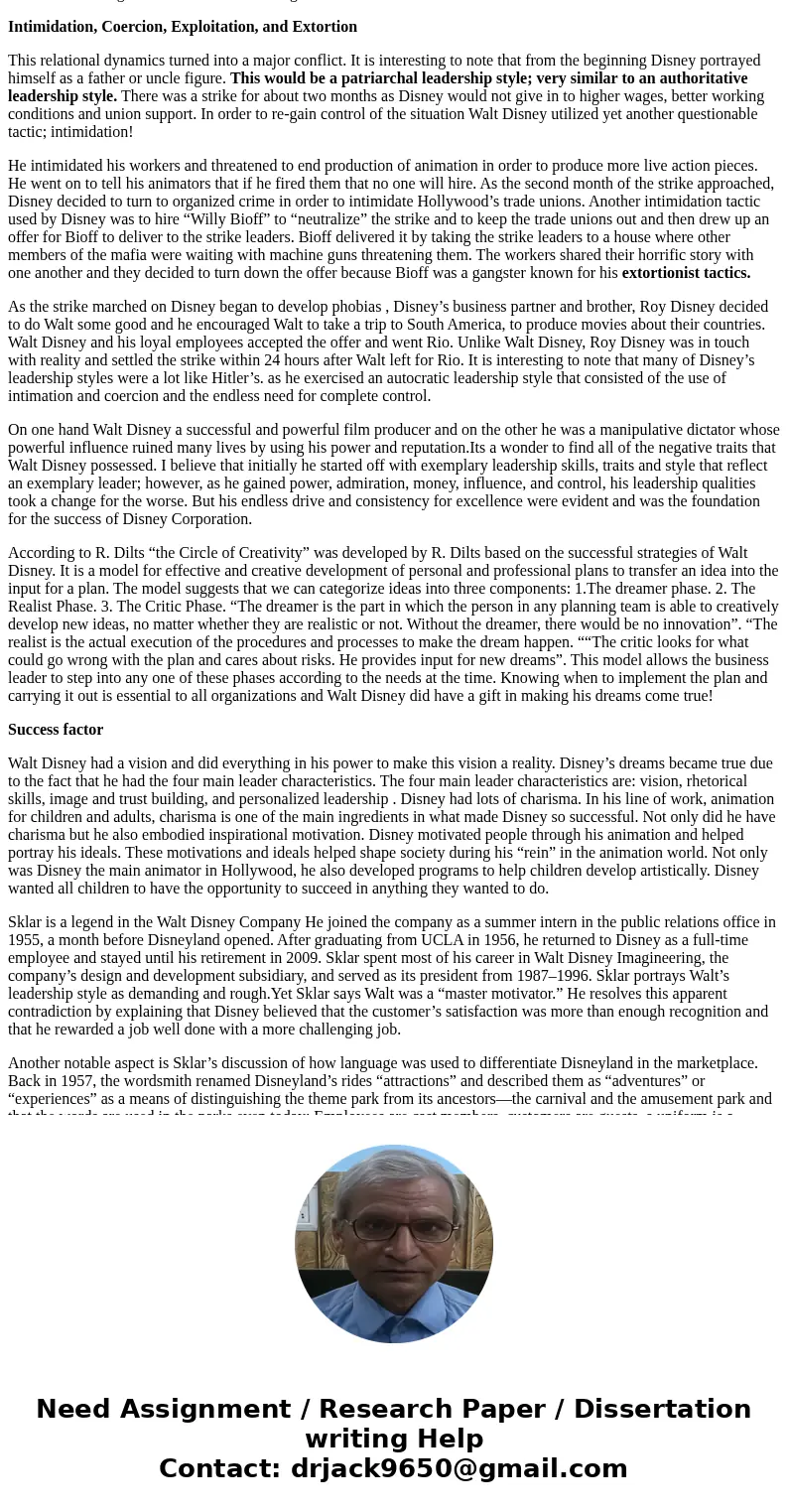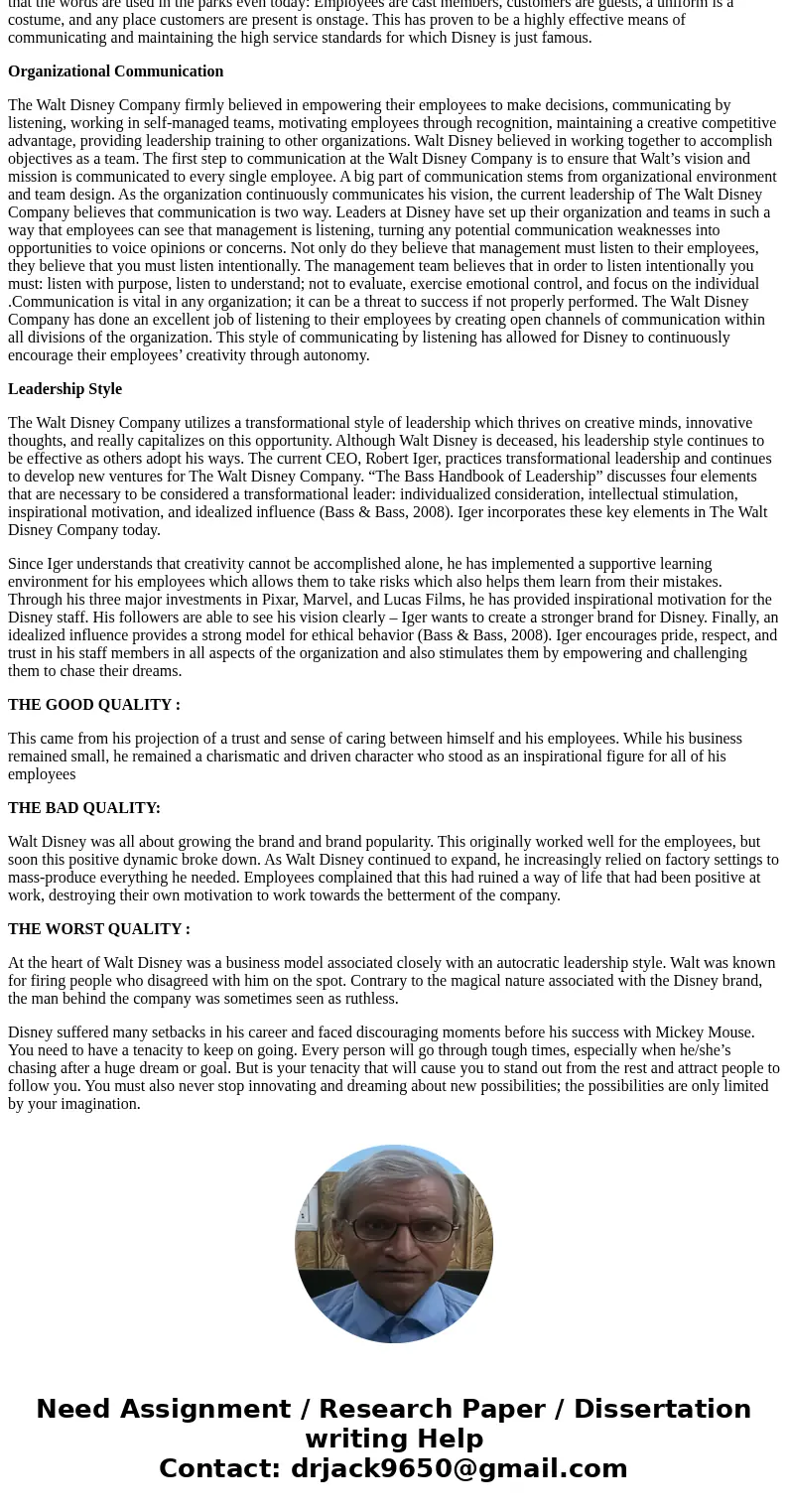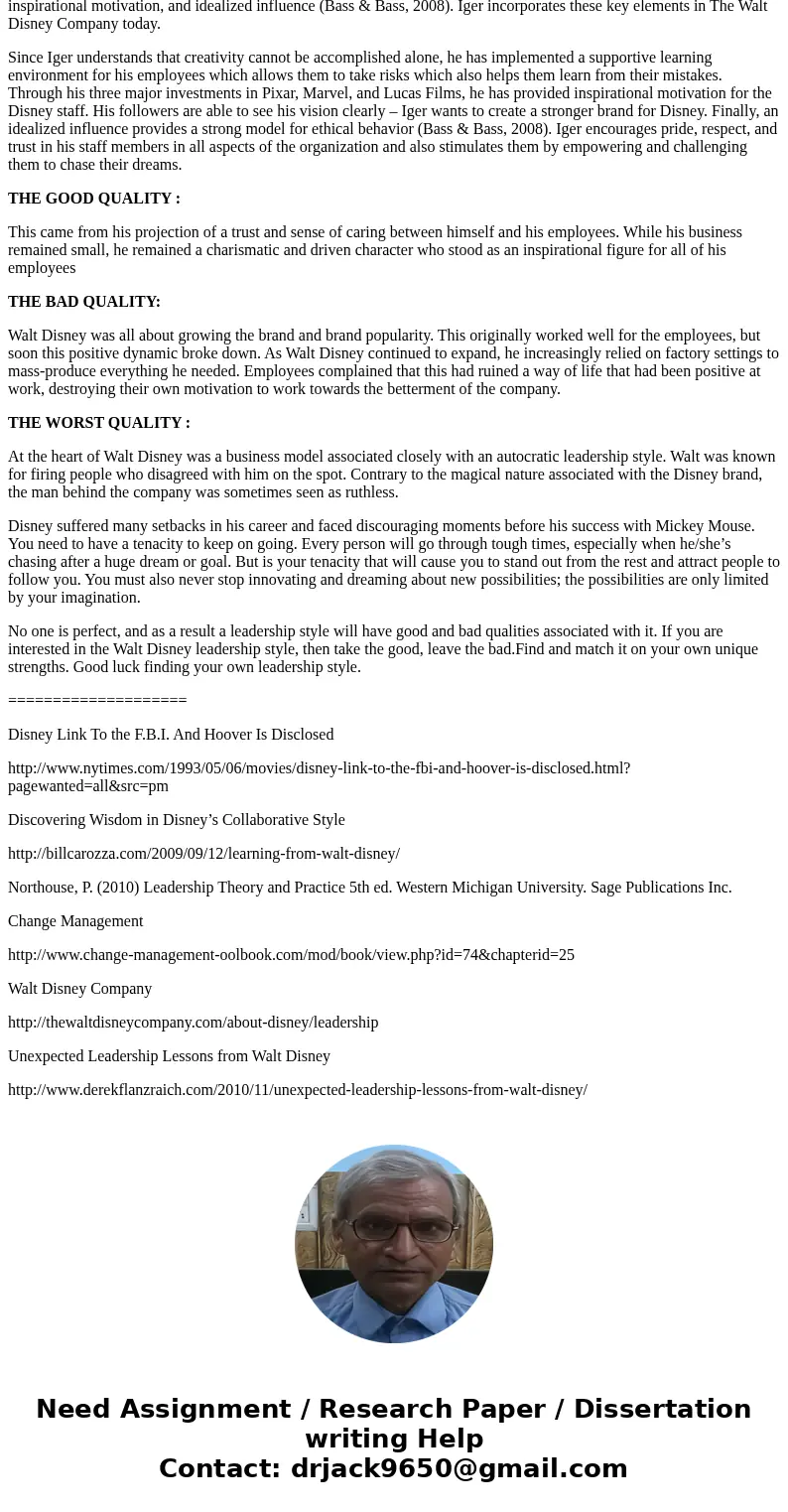Walt Disneys Definition of Leadership the ability to establi
Walt Disney’s Definition of Leadership: the ability to establish and manage a creative climate where people and teams are self-motivated to the successful achievement of long-term goals in an environment of mutual respect and trust
How did Walt Disney reflect his definiiton of leadership? Please be specific and use APA citaion to support your findings.
Solution
Walt Disney Leadership Style
In 1923,Walter Elias Disney along with his brother Roy , founded Walt Disney corporation which comprises of Disey books,movies,toys.He created theme park in 1954 namely Disney Land .He began all of these,just by drawing Cartoons with a passion for animation which later transformed into the world of entertainment and information.He set up his own art school to carry out his mission.
The mission of The Walt Disney Company was to be one of the world\'s leading producers and providers of entertainment and information creating portfolio of brands to differentiate the content, services and consumer products, to develop the most creative, innovative and profitable entertainment experiences and related products in the world. And today Disney is so successful in all of its operations because Walt Disney carried his vision and mission over into all areas of Disney.
Walt Disney was innovative and creative which allowed him to keep abreast with technology and dynamic business environment. He was evidently a risk taker and learned by trail and error .At 20 yrs of age,he started his own cartoon business .Through his excellence he came up with a way to synchronize animation with his characters which included the running cartoon,sound effects,character voices ad music all simulataneusly.And In 1928 ,Mickey Mouse came into theaters
Intial Days of Walt Disney :
The ability to establish and manage a creative climate where people and teams are self-motivated to the successful achievement of long-term goals in an environment of mutual respect and trust started its journey In 1936 when Walt Disney built his enterprise in Los Angeles, CA. He hired 700 highly skilled artistic employees to produce the best work and demanded excellence from his employees and in return he had his employees over for Sunday barbeques, playing games and swimming at his house. This instilled a sense of caring in the employees. He helped others by the offering to pay for their schooling to perfect their skill is a consistent trait of effective leaders.
His sociability ,casual and personal relationships built trust and confidence among his employees which Ultimately led his employees to happily work long hours without any pay because they believed in what they were doing. In 1936 “Snow White was released, his first big movie success bringing in over 8 million dollars in sales. As a result of which Walt Disney build a new studio with the help of hard working and loyal employees. It was here that his technological department made many break throughs. They designed the multi-playing camera and 3D was created and turned animation into a production line.
Effect of establishment of new studio
Autocratic style of leadership
Walt Disney exercised an autocratic style of leadership, when the employees complained about the factory like atmosphere and the less casual environment. His leadership style changed to be more authoritative or autocratic after he had moved into the new studio where he became more domineering and controlling. Disney began his mission treating his employees like family but after he moved to the new studio he became more rigid. There was no conflict resolution. If Walt didn’t like something the employees did or said he would fire them.
For example, He didn’t like Jewish people or African Americans. The personal department hired on a Hindu male and he was fired because his skin was too black. I believer overall that the many of the leadership styles and traits exercised by Walt Disney reflected by the sign of the times. For example by only allowing men to perform animations and women to perform the menial tasks was accepted in the Disney Corporation. At that time, women were still viewed as being oppressed and not capable of doing the work that a man could do. Walt Disney had intentionally segregated the men from the women. According to some workers the women were treated terribly by the supervisors as they would stand over the shoulders and watch them to determine whether they were good enough to keep on the job and some were fired. Walt Disney was known to take all of the credit for Disney Productions by accepting Oscars awards on many occasions without acknowledging any of the animators or other employees who were responsible for making it happen, leading to resentment among his artists. He was stealing the credit of the work of his workers.
Intimidation, Coercion, Exploitation, and Extortion
This relational dynamics turned into a major conflict. It is interesting to note that from the beginning Disney portrayed himself as a father or uncle figure. This would be a patriarchal leadership style; very similar to an authoritative leadership style. There was a strike for about two months as Disney would not give in to higher wages, better working conditions and union support. In order to re-gain control of the situation Walt Disney utilized yet another questionable tactic; intimidation!
He intimidated his workers and threatened to end production of animation in order to produce more live action pieces. He went on to tell his animators that if he fired them that no one will hire. As the second month of the strike approached, Disney decided to turn to organized crime in order to intimidate Hollywood’s trade unions. Another intimidation tactic used by Disney was to hire “Willy Bioff” to “neutralize” the strike and to keep the trade unions out and then drew up an offer for Bioff to deliver to the strike leaders. Bioff delivered it by taking the strike leaders to a house where other members of the mafia were waiting with machine guns threatening them. The workers shared their horrific story with one another and they decided to turn down the offer because Bioff was a gangster known for his extortionist tactics.
As the strike marched on Disney began to develop phobias , Disney’s business partner and brother, Roy Disney decided to do Walt some good and he encouraged Walt to take a trip to South America, to produce movies about their countries. Walt Disney and his loyal employees accepted the offer and went Rio. Unlike Walt Disney, Roy Disney was in touch with reality and settled the strike within 24 hours after Walt left for Rio. It is interesting to note that many of Disney’s leadership styles were a lot like Hitler’s. as he exercised an autocratic leadership style that consisted of the use of intimation and coercion and the endless need for complete control.
On one hand Walt Disney a successful and powerful film producer and on the other he was a manipulative dictator whose powerful influence ruined many lives by using his power and reputation.Its a wonder to find all of the negative traits that Walt Disney possessed. I believe that initially he started off with exemplary leadership skills, traits and style that reflect an exemplary leader; however, as he gained power, admiration, money, influence, and control, his leadership qualities took a change for the worse. But his endless drive and consistency for excellence were evident and was the foundation for the success of Disney Corporation.
According to R. Dilts “the Circle of Creativity” was developed by R. Dilts based on the successful strategies of Walt Disney. It is a model for effective and creative development of personal and professional plans to transfer an idea into the input for a plan. The model suggests that we can categorize ideas into three components: 1.The dreamer phase. 2. The Realist Phase. 3. The Critic Phase. “The dreamer is the part in which the person in any planning team is able to creatively develop new ideas, no matter whether they are realistic or not. Without the dreamer, there would be no innovation”. “The realist is the actual execution of the procedures and processes to make the dream happen. ““The critic looks for what could go wrong with the plan and cares about risks. He provides input for new dreams”. This model allows the business leader to step into any one of these phases according to the needs at the time. Knowing when to implement the plan and carrying it out is essential to all organizations and Walt Disney did have a gift in making his dreams come true!
Success factor
Walt Disney had a vision and did everything in his power to make this vision a reality. Disney’s dreams became true due to the fact that he had the four main leader characteristics. The four main leader characteristics are: vision, rhetorical skills, image and trust building, and personalized leadership . Disney had lots of charisma. In his line of work, animation for children and adults, charisma is one of the main ingredients in what made Disney so successful. Not only did he have charisma but he also embodied inspirational motivation. Disney motivated people through his animation and helped portray his ideals. These motivations and ideals helped shape society during his “rein” in the animation world. Not only was Disney the main animator in Hollywood, he also developed programs to help children develop artistically. Disney wanted all children to have the opportunity to succeed in anything they wanted to do.
Sklar is a legend in the Walt Disney Company He joined the company as a summer intern in the public relations office in 1955, a month before Disneyland opened. After graduating from UCLA in 1956, he returned to Disney as a full-time employee and stayed until his retirement in 2009. Sklar spent most of his career in Walt Disney Imagineering, the company’s design and development subsidiary, and served as its president from 1987–1996. Sklar portrays Walt’s leadership style as demanding and rough.Yet Sklar says Walt was a “master motivator.” He resolves this apparent contradiction by explaining that Disney believed that the customer’s satisfaction was more than enough recognition and that he rewarded a job well done with a more challenging job.
Another notable aspect is Sklar’s discussion of how language was used to differentiate Disneyland in the marketplace. Back in 1957, the wordsmith renamed Disneyland’s rides “attractions” and described them as “adventures” or “experiences” as a means of distinguishing the theme park from its ancestors—the carnival and the amusement park and that the words are used in the parks even today: Employees are cast members, customers are guests, a uniform is a costume, and any place customers are present is onstage. This has proven to be a highly effective means of communicating and maintaining the high service standards for which Disney is just famous.
Organizational Communication
The Walt Disney Company firmly believed in empowering their employees to make decisions, communicating by listening, working in self-managed teams, motivating employees through recognition, maintaining a creative competitive advantage, providing leadership training to other organizations. Walt Disney believed in working together to accomplish objectives as a team. The first step to communication at the Walt Disney Company is to ensure that Walt’s vision and mission is communicated to every single employee. A big part of communication stems from organizational environment and team design. As the organization continuously communicates his vision, the current leadership of The Walt Disney Company believes that communication is two way. Leaders at Disney have set up their organization and teams in such a way that employees can see that management is listening, turning any potential communication weaknesses into opportunities to voice opinions or concerns. Not only do they believe that management must listen to their employees, they believe that you must listen intentionally. The management team believes that in order to listen intentionally you must: listen with purpose, listen to understand; not to evaluate, exercise emotional control, and focus on the individual .Communication is vital in any organization; it can be a threat to success if not properly performed. The Walt Disney Company has done an excellent job of listening to their employees by creating open channels of communication within all divisions of the organization. This style of communicating by listening has allowed for Disney to continuously encourage their employees’ creativity through autonomy.
Leadership Style
The Walt Disney Company utilizes a transformational style of leadership which thrives on creative minds, innovative thoughts, and really capitalizes on this opportunity. Although Walt Disney is deceased, his leadership style continues to be effective as others adopt his ways. The current CEO, Robert Iger, practices transformational leadership and continues to develop new ventures for The Walt Disney Company. “The Bass Handbook of Leadership” discusses four elements that are necessary to be considered a transformational leader: individualized consideration, intellectual stimulation, inspirational motivation, and idealized influence (Bass & Bass, 2008). Iger incorporates these key elements in The Walt Disney Company today.
Since Iger understands that creativity cannot be accomplished alone, he has implemented a supportive learning environment for his employees which allows them to take risks which also helps them learn from their mistakes. Through his three major investments in Pixar, Marvel, and Lucas Films, he has provided inspirational motivation for the Disney staff. His followers are able to see his vision clearly – Iger wants to create a stronger brand for Disney. Finally, an idealized influence provides a strong model for ethical behavior (Bass & Bass, 2008). Iger encourages pride, respect, and trust in his staff members in all aspects of the organization and also stimulates them by empowering and challenging them to chase their dreams.
THE GOOD QUALITY :
This came from his projection of a trust and sense of caring between himself and his employees. While his business remained small, he remained a charismatic and driven character who stood as an inspirational figure for all of his employees
THE BAD QUALITY:
Walt Disney was all about growing the brand and brand popularity. This originally worked well for the employees, but soon this positive dynamic broke down. As Walt Disney continued to expand, he increasingly relied on factory settings to mass-produce everything he needed. Employees complained that this had ruined a way of life that had been positive at work, destroying their own motivation to work towards the betterment of the company.
THE WORST QUALITY :
At the heart of Walt Disney was a business model associated closely with an autocratic leadership style. Walt was known for firing people who disagreed with him on the spot. Contrary to the magical nature associated with the Disney brand, the man behind the company was sometimes seen as ruthless.
Disney suffered many setbacks in his career and faced discouraging moments before his success with Mickey Mouse. You need to have a tenacity to keep on going. Every person will go through tough times, especially when he/she’s chasing after a huge dream or goal. But is your tenacity that will cause you to stand out from the rest and attract people to follow you. You must also never stop innovating and dreaming about new possibilities; the possibilities are only limited by your imagination.
No one is perfect, and as a result a leadership style will have good and bad qualities associated with it. If you are interested in the Walt Disney leadership style, then take the good, leave the bad.Find and match it on your own unique strengths. Good luck finding your own leadership style.
====================
Disney Link To the F.B.I. And Hoover Is Disclosed
http://www.nytimes.com/1993/05/06/movies/disney-link-to-the-fbi-and-hoover-is-disclosed.html?pagewanted=all&src=pm
Discovering Wisdom in Disney’s Collaborative Style
http://billcarozza.com/2009/09/12/learning-from-walt-disney/
Northouse, P. (2010) Leadership Theory and Practice 5th ed. Western Michigan University. Sage Publications Inc.
Change Management
http://www.change-management-oolbook.com/mod/book/view.php?id=74&chapterid=25
Walt Disney Company
http://thewaltdisneycompany.com/about-disney/leadership
Unexpected Leadership Lessons from Walt Disney
http://www.derekflanzraich.com/2010/11/unexpected-leadership-lessons-from-walt-disney/




 Homework Sourse
Homework Sourse